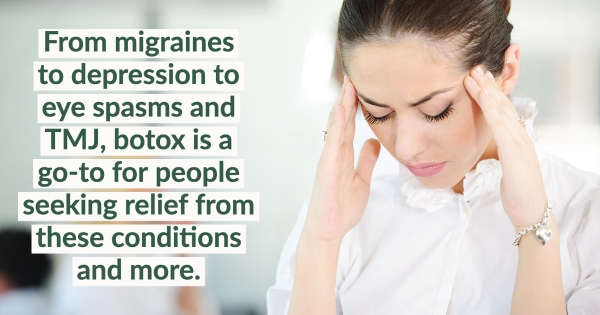Researchers Turn Frown Upside Down by Using Botox to Treat Depression
UPDATED 12/30/20
Over the past several years, Allergan has been increasingly interested in finding alternative uses for Botox injections. About 54% of sales for the muscle-paralyzing drug, in fact, are comprised of non-traditional uses. Instead of injections smoothing away wrinkles, they’re also treating chronic migraines, overactive bladders, and eyelid spasms. Right now, growth for these uses is outpacing the growth of Botox used for cosmetic enhancement.
According to new research from Hannover Medical School, Allergan might have another important usage to add to the lineup sometime soon. The German team discovered that a single injection of Botox could be an effective treatment for depression. In the study, patients were treated with Botox — also known as cosmetic botulinum toxin — which was used to eliminate frown lines. The team hypothesized that facial muscles can help inform our brains of how we “feel.”
“Our emotions are expressed by facial muscles, which in turn send feedback signals to the brain to reinforce those emotions. Treating facial muscles with botulinum toxin interrupts this cycle,” explained study investigator Professor Tillmann Kruger in a press conference with the American Psychiatric Association.
Out of 30 patients suffering from high levels of treatment-resistant depression, the research showed that those treated with Botox had a 47% reduction in the 17-item Hamilton Depression Rating Scale, compared to a 9% reduction among the placebo group that received a saline injection instead of Botox. “The study … supports the concept that the facial musculature not only expresses but also regulates mood states,” the research team noted.
In an exciting follow-up for patients suffering from chronic depression, the study’s findings have since been replicated twice by American researchers. Dr. Kruger’s team is also examining Botox’s potential to help with other psychiatric disorders.
“I agree with Dr. Kruger’s findings. Patients receiving Botox cosmetic to their frown lines have scored much better on depression score assessments. The emerging uses of Botox are uses in sweat management, migraines and scar improvement. In the case of scar improvement Botox is injected in the surrounding area to lessen muscle pull that may affect the tension on incision lines.” – Dr. Janis P. Campbell, Dermatologist at Laser Rejuvenation Clinic and Spa of Calgary.

When you think of Botox, you probably think of people treating wrinkles, but Botox is fast becoming a tool for treating anything but. From migraines to depression to eye spasms and TMJ, botox is a go-to for people seeking relief from these conditions and more. But is Botox safe and what can you expect after having the treatment? Is there recovery time and what are the side-effects? What is Botox made from? And what is the best brand of Botox? Answering these questions will help you decide whether Botox is right for you. After Botox treatment, there is no recovery time. You walk out of the doctor’s office, get in your car, and resume your normal activities. Botox composition consists of botulinum toxin type A and is produced by the bacterium Clostridium botulinum. Botox consequences, or side-effects, may include pain and swelling, bruising, headache, or flu-like symptoms. The best brand of Botox is the official Botox injection. You’ll want to be sure your doctor or other practitioner is using the official brand of Botox.
Related:
after botox wears off, age botox, beautiful botox, botox ages you, botox at 18, botox at 23, botox for cheeks before and after, botox marks, botox ruined my life, botox to make eyes bigger, botox where to get it, can botox ruin your face, do your own botox, does botox lift face, everybody botox, how old for botox, how old is too old for botox, how old to get botox, i want botox, people who do botox, same day botox near me.










